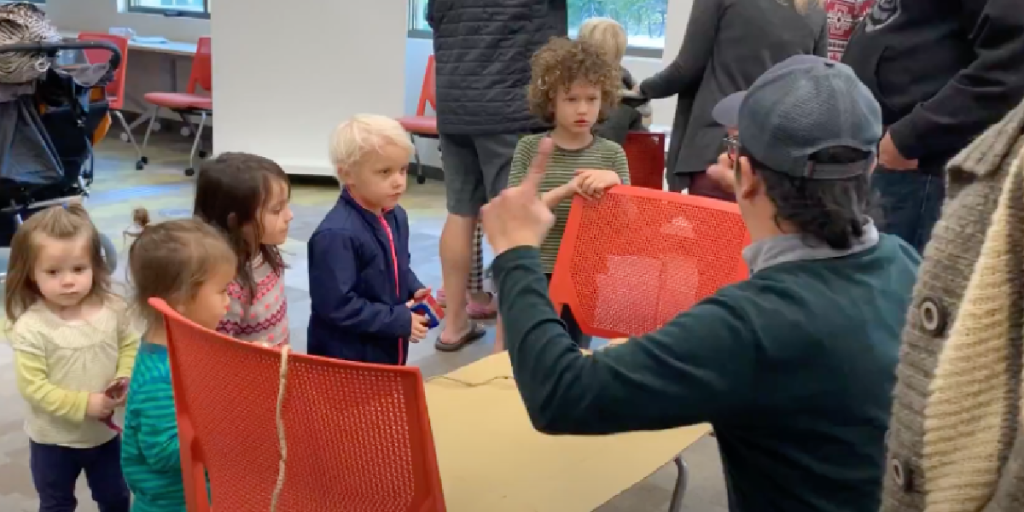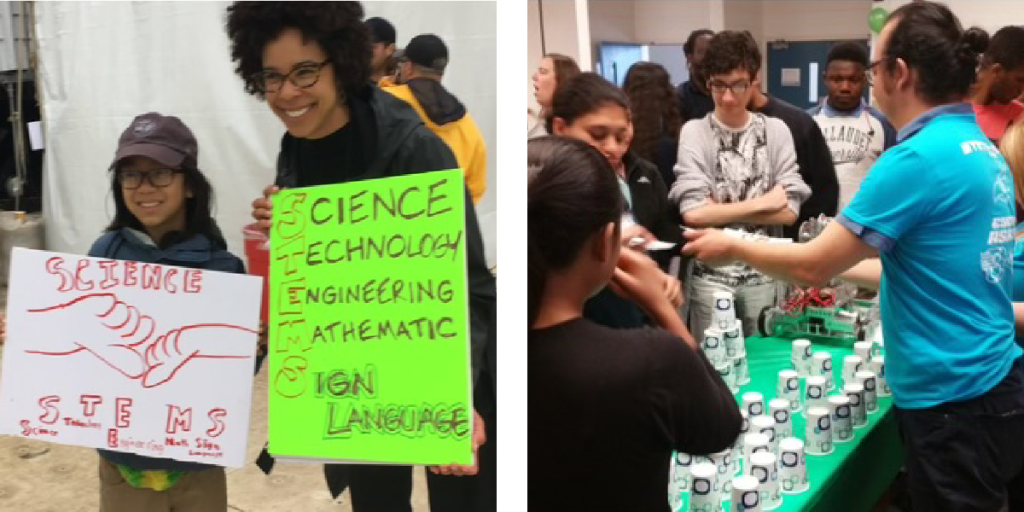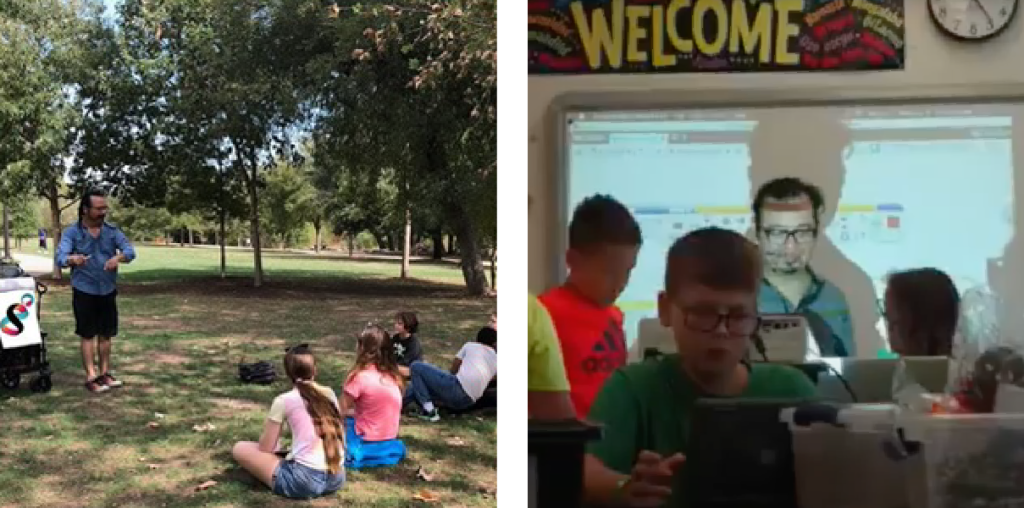Net-Zero Hero: Gabriel Arellano

I am helping to make Austin Net-Zero by elevating Sign Languages through STEM* education and sustainability.
Gabriel Arellano is many things: a father, entrepreneur, educator, advocate, member of the Deaf community, and Austin’s newest Net-Zero Hero!
Austin, home to the Texas School for the Deaf since 1857, has a rich, diverse, and thriving Deaf community. Each April 15, we join national celebrations of American Sign Language Day, a date that commemorates the opening of the American School for the Deaf in Hartford, Connecticut in 1817, which was specifically designed for the education of Deaf and hard-of-hearing students.
As a Heritage Signer and sustainability advocate, Gabriel has spent his life preserving and elevating Sign Languages while working towards environmental justice. His passions were put to practice when, in 2017, he founded STEMSign, or “STEMS,” an open education school focused on providing multilingual, hands-on learning in the fields of science, technology, engineering, and mathematics through American Sign Language and English.
We met with Gabriel to learn more about his journey, the mission of STEMS, and what it means to be a Heritage Signer.
* STEM refers to science, technology, engineering, and mathematics.
What inspired you to take action?
I grew up in New Mexico surrounded by Native Americans, Pueblos, Mexicans, and other peoples who have practiced traditional Indigenous knowledge for millennia. Sustainable practices were carried out daily. The traditional knowledge of Indigenous peoples has always been present in my life and was shared as a way to nurture our planet. We used our hands, minds, and all we had available to us throughout our daily lives.
In my elementary years, I became really interested in endangered species. As I grew older and traveled out of New Mexico to places like Texas and Washington, D.C., I was shocked to find fewer Indigenous practices and more pollutants. I came to see parallels between the endangered species I researched as a child and our Sign Languages — both threatened with extinction.

Gabriel pauses during our photoshoot to take a photo of a blue heron in Blunn Creek.
While living on Capitol Hill in Washington, D.C., my son went to STEM workshops that were very costly. Often, I would find that there were no people of color, individuals living with disabilities, girls or women, or lower-income families included in the participants. We decided to look for a solution.
How did you do it?
My son and I founded STEMS on April 15, 2017. STEMS focuses on STEM education within Sign Languages. We believe in three main ideas: PLAY WELL, SYNERGIZE, and ELEVATE. What does that look like?
PLAY WELL: We learn from playing.
STEMS’ first hands-on activities began in front of the statue of Edward Miner Gallaudet at the Laurent Clerc National Deaf Education Center, located on the campus of Gallaudet University in Washington, D.C. The activities took place on April 15, 2017, which marked the 200th anniversary of the opening of the American School for the Deaf, which elevated the use of American Sign Language. Our first STEMS-led activities focused on the topic of hydrogen with families of deaf children from birth to 5 years old.
SYNERGIZE: Collaboration leads to synergy.
In November 2017, STEMS hosted a Native American Heritage Month event along with DMVKODA (District/Maryland/Virginia Kids of Deaf Adults). We ran hands-on activities at American University with STEM resources through the Smithsonian’s National American Indian Museum.

Students gather at the first STEMS Native American Heritage Month celebration at American University in Washington, D.C. Photo courtesy of STEMS.
This past July, I was selected as a World Deaf Leader to participate in the Deaf Leadership Workshop and The World Federation of the Deaf’s World Congress in Jeju, South Korea. I created a CLIMATE SIGNS group of Deaf world leaders to practice and increase sustainability literacy as part of collective liberation.
ELEVATE: Find new ways to use Sign Languages and to support those who use them.
STEMS adopted Blunn Creek through Keep Austin Beautiful’s Adopt a Creek Program. This allows us to become immersed in nature regularly. As part of our adoption program, we do hands-on activities that bring people together to learn and play in Sign Language.
Gabriel stands at the edge of Blunn Creek and shows us the words for Creek, Stream, River, and Lake in ASL.
What’s been most rewarding about getting involved in this way?
When I see someone practice Sign Language, I see their knowledge and spirit get brighter. Sign Languages are visual, making it easy to synergize our mindsets to see and know that we are all “one” together. They are languages of love and liberation.
Yet, there is still so much to do as our planet is not healthy. I see Sign Languages as one solution to the climate crisis!

Left: Gabriel’s son, Tonatiuh, holds up handmade STEMS signs with world-renowned climate scientist, Dr. Ayana Elizabeth Johnson; Right: Gabriel at Laurent Clerc National Deaf Education Center in Washington, D.C teaching the center’s first robotics lesson. Photos courtesy of STEMS.
What’s been the toughest part?
I do stay optimistic and focus on educating all living beings about wellness as an essential part of our mission in STEMS. But the climate crisis is quite concerning. We have to acknowledge that human beings are causing harm to ourselves, our climate, and our planet.
I have seen non-Deaf people use Sign Language for financial gain, which causes damage to the Deaf community and Sign Languages as a whole. Children who are Deaf suffer from language deprivation, which limits their ability to learn and develop.
The aim of STEMS is to close the exposure gap in Sign Language learning, especially for underrepresented communities. We are committed to using sustainability and other educational advancements to prepare individuals for careers in STEM across industries.
You describe yourself as a heritage signer. Can you explain to us what that means?
Being Deaf and Mayan/Aztecan, I consumed Sign Language through my Deaf-Mexican family in our own Lenguaje de Senas Mexicana (LSM), which is part of our heritage and ancestry. I went to two different Deaf schools where we shared our storytelling and learning developments in American Sign Language (ASL), which was revitalized a few decades ago. Therefore, having been raised by a Deaf family that uses LSM and having learned ASL through Deaf schools, clubs, and organizations, this became who I am — a Heritage Signer.
I studied Sign Languages during my college years and obtained degrees in Signed Language Linguistics, Anthropology, ASL/Deaf Studies, and Language Documentation. Sign Language is not a universal language. Just like every written and spoken language, Sign Languages are different in regions globally.
Through STEMS, you’ve worked with organizations to help “close the exposure gap” for those in the sign language community around science, technology, engineering, and mathematics. From your experience, what can organizations in these fields do to create more inclusive experiences for community members who sign?
I see the growth of acceptance and acknowledgment of the Deaf community when organizations make the effort to include us and help us thrive through proper accommodations while striving for equity with zero barriers.
For example, rather than focusing on hiring interpreters, STEMS strives to consult with and hire predominantly Deaf experts to support our mission. Through this act, we elevate Sign Languages into multilingual and multicultural media, including events, books, videos, and more.

Gabriel signs the word for “sustainability” in front of Blunn Creek.
We’ve had the opportunity to collaborate with:
- Smithsonian Science Education Center
- City of Austin’s Office of Sustainability
- ASL Aspire
- CapMetro and Project Connect
- Texas Tribal Buffalo Project
- Sustainable Food Center
- Waterloo Greenway Conservancy
- Austin Area Homeschoolers Chess Club
- George Washington Carver Museum
- University of Texas
- Texas' Statewide Outreach Center
- Texas Association of the Deaf Senior Citizens
- Patagonia (which I am wearing for our photoshoot today and wear nearly every day!)
- BrownGirl-Green: Kristy Drutman
- Susie Hicks the Climate Chick
- ASL Slam
- Sustain the Mag
- UrbGarden
- and many more!

Left: Gabriel leads a STEMS activity at Pease Park in Austin; Right: Gabriel teaches students about renewable energy and space at Texas’ Statewide Outreach Center. Photos courtesy of STEMS.
Is there a book, documentary, or other piece of media you would recommend for folks wanting to learn more about these topics?
My recommendations are:
- Step Into the Circle: The Heartbeat of American Indian, Alaska Native, and First Nations Deaf Communities by Damara Goff Paris, and Sharon Kay Wood
- Sign Language Archaeology: Understanding the Historical Roots of American Sign Language by Ted Supalla & Patricia Clark
- Silence of the Spheres: The Deaf Experience in the History of Science by Harry G. Lang
- When the Mind Hears: A History of the Deaf by Harlan Lane
- That Deaf Guy: A Family Portrait and That Deaf Guy: A Wide Ride by Matt and Kay Daigle
And I encourage everyone to keep an eye out for STEMS’ storybook apps in the near future!
Gabriel stands in front of a mural off of Congress Avenue that says “NO THANKS” and “HARD PASS.” In ASL, he says, “Hey! Fossil fuels, air pollution — both are not sustainable.”
What advice do you have for others?
Turn off your television and computers and go out to experience life. Mingle with people who share sustainability values.
Practice Land Back — a movement to get Indigenous lands back into Indigenous hands — to honor our traditional Indigenous knowledge.
Remember that nature is not “ours” to rule or command. We are just another element of nature.
Do not stop acting until every being (plants, animals, and all) is liberated from oppression.
And lastly, take time to learn and practice Sign Languages. Try to practice for one hour per day or even just learn one word per day.
Gabriel stands on Congress Avenue, pointing out the connection between the Texas School for the Deaf and the city.
Follow STEMSign on Youtube for updates from Gabriel and his team. If you'd like to grow your proficiency in American Sign Language, UT Austin offers a free online resource. Explore the history of Sign Languages in the United States with this 2022 video from PBS's Otherword series. To learn more about Austin's net-zero goal and explore actions you can take to support a greener community, view the Austin Climate Equity Plan.
Share your Net-Zero contributions with us on X (formerly Twitter) or Facebook, and use #NetZeroHero. If you know a Net-Zero Hero (or heroes!) who should be recognized for their efforts, send your nomination to sustainability@austintexas.gov.

